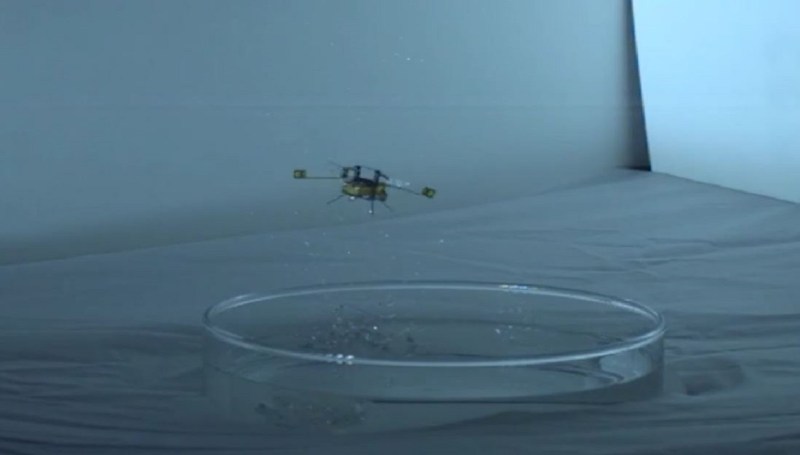You’ve probably heard of micro-drones, perhaps even nano-drones, but there research institutions that shrink these machines down to the size of insects. Leading from the [Wiss Institute For Biologically Inspired Engineering] at Harvard University, a team of researchers have developed a miniscule robot that — after a quick dip — literally explodes out of the water.
To assist with the take off, RoboBee has four buoyant outriggers to keep it near the water’s surface as it uses electrolysis to brew oxyhydrogen in its gas chamber. Once enough of the combustible gas has accumulated — pushing the robot’s wings out of the water in the process– a sparker ignites the fuel, thrusting it into the air. As yet, the drone has difficulty remaining in the air after this aquatic takeoff, but we’re excited to see that change soon.
Looking like a cross between a water strider and a bee, the team suggest this latest version of the RoboBee series — a previous iteration used electrostatic adhesion to stick to walls — could be used for search and rescue, environmental monitoring, and biological studies. The capacity to transition from aerial surveyor, to underwater explorer and back again would be incredibly useful, but in such a small package, it is troublesome at best. Hence the explosions.
In larger drones, the challenges are a bit more forgiving, as seen here.
[Via The Wyss Institute]
















cool, but will this scale up where you dont have to tether it to a controller?
Yep. But the size and time vectors are bound together. So: it will scale up, but it will take a few years. :)
Love that we can make water explode.
With chlorine trifluoride, you can make it burn/explode at the same time ;-)
where can you get those electrolytic plates?
I don’t think they are that special. Looks like two photo etched combs held together with some Kaptan tape. A DIY setup which focusses a small image on a piece of aluminium foil sprayed with photoresist, should have it a possibility to make them in your basement.
Why stay with a flappy bicopter? A small bottle under water with a H2+O2 generator in the top making 25% or so of the volume gas, is then combusted to drive the rest of the water out.
Did I miss a memo that made people unimpressed by functional, controllable, Ornithopter (entomopter?) anymore?
Yes, we now are officially living in the future.
Besides, we found out about brainwashing fruit flies last week, so building insects yourself seems a bit unnecessary now.
Bio-robotics where one co-opts an organism is a much closer thing than trying to get mechanical/electrical to behave like organic.
Is it controllable or free swim/flight/blowup?
Spybots can hide in the bathtub.
This is a robot in the same sense that Homer Simpson’s robot wars creation is a robot. Not autonomous, not even controllable, not even untethered. It’s just a motor and two passive components stuck to a model.
That ship has sailed. You remind me of the people who complain about calling the US “America” sure it may not be technically accurate but it is generally accepted and you just look silly when you complain about it.
A novel arrangement for sure!
I wish they had used a different term from ‘oxyhydrogen’ now the interminable HHO free energy loons are going to co-opt this work.
I question this things role in SAR operations, frequently these are conducted near crash sites or industrial accidents where flammable chemicals abound, purposefully causing an explosion may not be the safest course of action.
Does anyone know of any studies into the efficiency of ornithopter vs conventional or multi-rotor flight? I can imagine there are scenarios where you don’t care how inefficient it is, but it’d be useful information to have.
Wow !!! Those guys are genius, they made the first farting drone !
Respect !